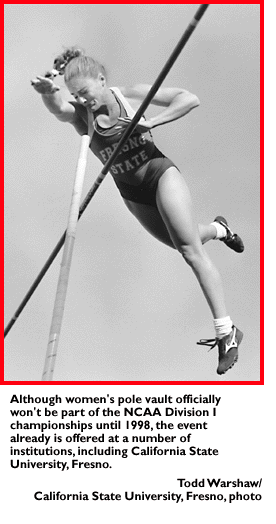The NCAA News - News and FeaturesApril 7, 1997
POLE-itically correct
Adoption of women's pole vault in Division I will make the number of championships events equal to men's and take advantage of the surging popularity of the event
BY STEPHEN R. HAGWEL
Staff Writer
Women track and field athletes have soared to great heights since the inception of NCAA women's championships in 1982.
 Beginning in 1998, they will soar to even greater heights with the debut of women's pole vault as an NCAA-sponsored event at Division I women's track championships.
Beginning in 1998, they will soar to even greater heights with the debut of women's pole vault as an NCAA-sponsored event at Division I women's track championships.
At its December 1996 meeting, the NCAA Executive Committee approved a recommendation from the Division I subcommittee of the NCAA Men's and Women's Track Committee to add women's pole vault at both the indoor and outdoor championships, effective with the 1998 meets. The Executive Committee also increased the number of women participants at the indoor championships from 254 to 270 and at the outdoor championships from 373 to 388.
Adoption of the event gives the Division I women's championships the same number of events (16 indoors and 21 outdoors) and participants as the men's championships.
The Divisions II and III subcommittees of the Men's and Women's Track and Field Committee plan to survey their respective coaches in April to gauge the level of interest in the event.
"(The Division I subcommittee) felt it was time to push the event forward, and also help with the equity issue as far as numbers with regard to men's and women's track and field," said Lauren E. Anderson, associate director of athletics at the University of Rhode Island and chair of the committee. "We are well aware that the event is being used experimentally throughout the country and that student-athletes have been practicing and competing for several years. We felt that it was time to be proactive, rather than wait too long and let things take their own direction."
Once viewed solely as a men's event, pole vault recently has gained considerable popularity as a women's event. The Division I men's championships have contested the event since 1921.
Numerous collegiate institutions -- including NCAA members California State University, Fresno; the University of California, Los Angeles; Stanford University; the University of Oregon; Idaho State University; and Utah State University -- offer the event. The National Association of Intercollegiate Athletics also sponsors the event at its championships.
The event also is conducted at USA Track and Field's indoor and outdoor championships and at international championships. In March, women's pole vault made its debut at the International Amateur Athletic Federation (IAAF) World Indoor Track Championships in Paris. Stacy Dragila, a former Idaho State heptathlete, won the competition with a championships-record tying mark of 4.40 meters (14 feet, 51/4 inches). The IAAF will showcase the women's pole vault for the first time outdoors at its 1999 world
championships.
On the high-school level, 13 states -- including California, Florida, New Hampshire, Oregon, Washington and Wisconsin -- currently offer girls' pole vault as a scored event at their state championships. Iowa and Alaska are the only states that do not offer pole vault for boys or girls.
A pole-vault summit held in January in Reno, Nevada, attracted nearly 600 athletes and coaches, of which 200 were women. The summit was sponsored in part by USA Track and Field.
"The event has really taken off," said Bob Fraley, head indoor track coach and assistant outdoor track coach at Fresno State and chair of pole-vault development for USA Track and Field. "There's a tremendous amount of interest on the high-school and college level.
"I won't be surprised if the women vaulters outnumber the men in a few years."
Surprisingly, the explosive growth of the event has been largely influenced by another sport: gymnastics. Supporters state that women with gymnastics backgrounds are taking up the event and attaining great success because they are a "natural fit," given that the pole vault requires some of the same attributes as gymnastics: precise timing and technique, and a strong upper body.
"What we're finding is that gymnastics is an excellent preparation for the vault," said Fraley, adding that Fresno State's men's vaulters this past year included gymnastics as part of their pole vault training. "Women who have spent time at gymnastics and have come into the pole vault are actually better prepared and vault safer than their male counterparts."
Considering the short amount of time that the event has been offered, some people might wonder if adding the event at the 1998 championships is premature.
Anderson doesn't believe so. She says that although the event currently is not offered at the NCAA championships, the competitive level of the event is very high, and continues to increase.
"Women have been training and competing in the event, but now they'll have additional opportunities to improve their technique through training and competition," Anderson said. "That additional training and competition will move the event much more quickly to a level of quality competition by the time we get to the (1998) nationals."
|